英语句型全倒装和半倒装
倒装句的三大类别

倒装句的三大类别袁黎胡同梅倒装句是高中英语语法的重要组成部分,包括语法倒装句和修饰倒装句。
根据倒装方式的不同,可以分为三类,即全部倒装、部分倒装和不分主谓顺序只强调部分推进的倒装。
例如:I write a book.全部倒装为: Write I a book. (全部倒装要将整个谓语部分提到主语的前面)部分倒装为: Do I write a book. (部分倒装就是将原句变为一般疑问句)强调部分提前与主谓顺序无关的倒装为: a book I write.一、全部倒装1. 以副词如:表示地点的副词here/there,表时间的副词now/then,表位移的副词up/down, in/out, away, off等开头,且主语为名词的句子要全部倒装。
例如:①The bus es here.倒装句为:Here es the bus.(此句满足了以上两个条件:以副词开头;主语是名词)②When the bell rang, the children rushed out.倒装句为:When the bell rang, out rushed the children.注意:以下句子不能全部倒装。
③He came here.只能改为: Here he came.(此句只满足了副词开头的条件,而另一个条件,主语必须是名词没有满足,故不能改成全部倒装句)2.表示方位的介词短语的开头(不管介词短语是在主句的开头还是从句的开头)。
例如:①A boy stood in front of the classroom.倒装句为: In front of the classroom stood a boy.②A little girl sat between the old couple.倒装句为:Between the old couple sat a little girl.③I used to live in a small village, throught which flowed a river.陈述句为: A small river flowed a river.④When we got to the playground, we found a sign on which was written “wet paint”.陈述句为:“wet paint” was written on the sign.3. 表语提前的倒装(一般情况下含有be动词的短语构成的句子都可以变成表语提前的倒装形式)。
英语倒装句分两种

英语倒装句分两种1. 整个谓语在前的句子,叫完全倒装,如:Here comes the car.2. 部分谓语(情态动词、助动词、连系动词)在前,谓语的主体部分仍在主语之后,的句子,叫部分倒装句。
如:Only then did he realize that he was wrong. 所以要弄清两点:1.若有主从句,哪句倒装。
2. 部分倒装还是完全倒装。
一、表示方位和时间的副词位于句首时(now, then ,here, there, out, in ,up, down, away, back, off, on/),句子全部倒装。
(当主语是代词时,不倒装。
)如:1. Here comes the bus.2. There goes the bell.3. Away went the students.4. Now comes the chance.5. Out he rushed.(主语是代词,不倒装)6. There he comes.(同上)二、以介词短语表示的状语,提前位于句首时,全部倒装。
1. In a lecture hall of a university in England sits a professor.2. In front of our school stands a tower.3. By either side of the river grow a lot of apple trees.4. At the top of the mountain stands a temple.5. Among the goods are Christmas trees, flowers and toys.三、表语位于句首时,倒装结构为“表语+连系动词+主语”A: 形容词+连系动词+主语例1.Present at the meeting were Professor White,Professor Smith and many other guests.例2.过去分词+连系动词+主语Gone are the days when they could do what they liked to the Chinese people.四、将so\neither \nor 放在开头,表示“…也(不)…”的意思时,部分倒装(表示“确实是这样”时,不倒装)1.He went to the film last night.So did I .2.You must finish your work ,so must I .3.She is interested in the story ,so am I .4.He didn’t turn up .Neither did his brother .5.His mother told him not to go to the film .So he did.五、在if 条件句中,通常可以省略if ,而将从句倒装条件:在if 条件句,必须含有系动词were, 助动词had 和情态动词should1.Were he younger(=If he were younger ),he would learn skating .2.Should they forget (=If they should forget ) to bring a map with them ,they would get lost in the woods .3.Had they realized (=If they had realized ) how important the task was ,they wouldn’t have refused to accept .4.Were I you ,I would help her .六、否定词或半否定词(never .little ,seldom ,not ,nowhere ,scarely ,few ,by no means ,at no time )位于句首,应部分倒装1.Never have I been there .2.Little did I know about it .3.Seldom did she come late to school .4.Not a single mistake did he make .5.By no means should you buy that kind of car .七、以not until ,no sooner …than , hardly …when ,not only …but also 所引导的状语放在句首时,需要部分倒装1.Not until 10’clock will the library open .2.No sooner had I gone out than he came to see me .3.Hardly had the train arrived when I ran to meet my friend.4.Not only does she speak English but also she follows the British way of life .八、only 及其修饰的状语位于句首时,后面的句子部分倒装。
英语中的完全倒装和局部倒装
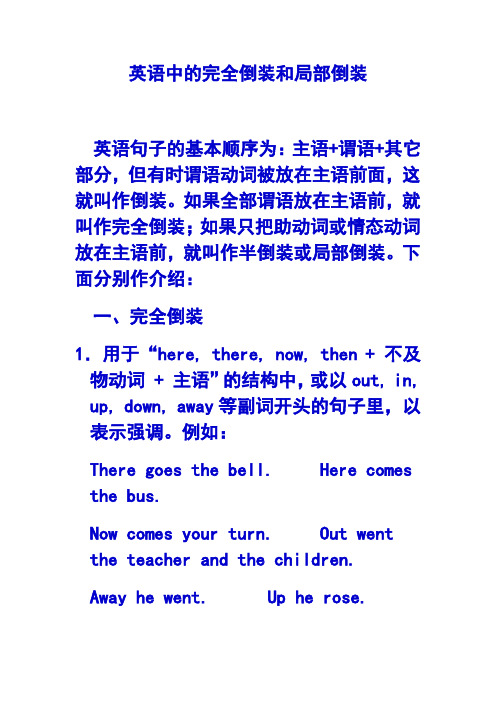
英语中的完全倒装和局部倒装英语句子的基本顺序为:主语+谓语+其它部分,但有时谓语动词被放在主语前面,这就叫作倒装。
如果全部谓语放在主语前,就叫作完全倒装;如果只把助动词或情态动词放在主语前,就叫作半倒装或局部倒装。
下面分别作介绍:一、完全倒装1.用于“here, there, now, then + 不及物动词 + 主语”的结构中,或以out, in, up, down, away等副词开头的句子里,以表示强调。
例如:There goes the bell. Here comes the bus.Now comes your turn. Out went the teacher and the children.Away he went. Up he rose.2.用于“there be”的结构中,例如:There were many boys and girls on the playground just now.There will be a new station near our school.3.当介词短语或地点状语放在句首作状语时,例如:North of the city lies/is a new airport.From the valley came a frightening sound with some cries.4.表语放句首时倒装结构为:“表语+连系动词+主语”,例如:Present at the meeting is our English teacher.Gone are the days when we had a good time at the mountain village.In the middle of the room stand twodesks and some chairs for the party.5.当“so/such… that”结构中的so或such 位于句首时,例如:So beautiful was she that many men would like to dance with her at the party.Such an honest boy is he that he gave back the change to me after shopping.6.用于so, nor, neither开头的句子,表示重复前面的内容,原句的谓语应与前面的谓语动词的时态、形式等相一致。
【英语知识点】部分倒装与完全倒装的区别

【英语知识点】部分倒装与完全倒装的区别完全倒装与部分倒装是英语中常见的语法现象,但是不少的同学却对于两种倒装的形式和意义无法准确地理解和把握。
本文整理了二者的区别,希望对你有所帮助。
倒装句是将正常的陈述语序加以变化,主要作用是强调被提前的部分,分为两种:一、全部倒装:谓语动词提前至主语之前;二、部分倒装:助动词或情态动词提至主语之前,谓语动词位置不变。
一、全部倒装示例如下:1、Here,There,Now,Then等副词放在句首时,句子要全部倒装,谓语动词常用e,go,be,lie,run等。
例如:There es the bus!Now es your turn.2、表示方位的副词或介词短语置于句首时,句子要全部倒装,句中的谓语动词是e,go等表示运动的动词。
The door opened and in came the headmaster.二、部分倒装示例如下:1、否定副词如no,not,never,seldom,little,hardly,以及含有no,not的短语放在句首时,句子要部分倒装。
Never in my life have I heard such a thing. Little did we expect that he could e.注意:如上述句子中的否定副词不置于句首时,句子结构不倒装。
2、以否定词开头的关联结构No sooner…than…,Hardly/scarcely…when…,Not only…but also,Not until…有承上启下作用,表示同意和赞同:例:A: I couldn't do anything for her.(我帮不了她。
)B: Nor you could, but you might have got somebody to help her.(你是不能帮她,但你本可以找人帮她的。
)2) 在进行比较的句子里,如果主语不是代词时,可以倒装:例:America consumes more energy than did our country.(美国消耗的能源比我们国家多。
高中英语语法倒装句

1.His mother had talked to him for many minutes while he was watching TV, but ____. A. a little did he hear B. little did he hear C. little heard he D. a little heard he 2.—— Hello, Zhu Hua. I’ll have to return to Canada because I’ve worked here for a year. —— _____! What time flies B. How time flies C. What does time fly D. How does time fly 3. During the war, ____but also he lost his wife and his child. not was his job in the lab taken away B. not only was his job in the lab taken away C. not merely his job in the lab was taken away D. not just was taken away his job in the lab
C
D
11.— The old man wouldn’t stay at home for a rest even if it rained. — ____.He would feel sick if he stayed home for one day. A. So would my grandpa B. So wouldn’t my grandpa C. Neither would my grandpa D. Nor wouldn’t my grandpa 12.___for us to surf (冲浪) on the sea in summer! A. What exciting is it B. How exciting is it C. What exciting it is D. How exciting it is 13.By no means ___ to our plan for the trip. A. will she agree B. she will agree C. agrees she D. will agree she
初中英语倒装句归纳为7种类型

初中英语倒装句归纳为7种类型倒装句是英语中的一种特殊句型,它与正常语序的句子相反,通常用于强调、疑问、感叹等语境。
在初中英语学习中,掌握倒装句的基本类型和用法是非常重要的。
以下是初中英语倒装句的七种类型:1.完全倒装:这种倒装句中,主语和谓语完全颠倒位置,通常用于强调或描述性语句。
例如:“In the room sat an old man.”(房间里坐着一个老人。
)2.部分倒装:只有助动词、情态动词或be动词与主语交换位置,其他部分保持正常语序。
例如:“Never have I seen such a beautiful sunset.”(我从未见过如此美丽的日落。
)3.疑问倒装:在一般疑问句中,助动词或be动词提前,形成疑问倒装。
例如:“Do you likeapples?”(你喜欢苹果吗?)4.强调倒装:通过使用“only + 状语”或“not only ... but also”等结构,可以形成强调倒装。
例如:“Only in this way can we solve the problem.”(只有这样我们才能解决问题。
)5.so/neither/nor倒装:当表示“也”或“也不”时,so、neither或nor引导的句子会采用部分倒装。
例如:“He studies hard, and so do I.”(他学习努力,我也一样。
)6.as/though引导的倒装:在as或though引导的让步状语从句中,通常会将表语或状语提前,形成倒装。
例如:“Child as he is, he knows a lot.”(尽管他还是个孩子,但他知道很多。
)7.虚拟条件句中的倒装:在虚拟条件句中,如果省略了if,且条件句使用了were、had或should,那么条件句需要采用部分倒装。
例如:“Had I known earlier, I would have helped.”(如果我早知道,我就会帮忙。
英语 倒装(全部倒装和部分倒装)

部分倒装句的具体用法
3. so…that 结构中的 so 置于句首时,需要部分倒装。 例如:So absurd did he look that everyone stared at him. 句首是 many a time, to such a degree / extent, to such a extremes, to such a lengths, to such a point, with every justification, with good reason 等状语时,句 子需要部分倒装。 例如:To such a degree was he excited that he couldn’t go to sleep that night.
部分倒装句的具体用法
2. 句首是 only 引导的状语时, 需要部分倒装。 例如:Only in this way can we solve the problem. 常用短语还有:only by chance, only then, only with difficulty, only on a rare occasion 等等。
部分倒装句的具体用法
6.在比较和方式状语从句中,如果主语不是人称代词,
常在主语前加助动词 do / did 代替前面已出现过的动词。 例如:I spend more than do my friends. She traveled a great deal as did most of her friends.
全部倒装句的具体用法
5.用于表示祝愿的句型。 例如:May you live a long and happy life ! Long live the People’s Republic of China !
英语完全倒装和部分倒装--解决不易懂

完全倒装完全倒装则指将谓语动词完全(全部)置于主语前。
完全倒装一般具有以下两个条件:①谓语动词是单个(即不带情态动词、助动词或be)的不及物动词,且只限于一般现在时或一般过去时。
②主语只能是名词。
Here comes the bus. 公共汽车来了。
Away went the runners. 赛跑选手们跑远了。
The door opened and in came Mr Smith. 门开了,史密斯先生进了来。
注:若主语为人称代词,则不能用倒装。
如:Away he went. 他跑远了。
主要分为以下几种类型:1.there/here/then/now/next 等地点副词和时间副词+V.+主语2.up/down/off/out/in/away 等表示运动方向的副词+V.+主语3.in the room, on the wall + V+主语等介词短语+V.+主语4.such+ be.+主语用法说明与经典例句:1.在以here , there 等表示地点的here型副词开头的句子里,要用全部倒装以示强调。
在描述情景时,为了使景象更生动,有时把here, there, now, then, out, in, up, down, off, away等方向性副词作为句子开头,句子用完全倒装。
此时,①子主语必须是名词;②谓语动词通常是be, come, go, run, rush, fly, follow, fall等表示位移的不及物动词,且为一般时态;③其中的here, there不是表示地点,而是用以引起对方注意。
如:here comes the bus.There is a hole in the wall.Here are some advertisements about cars. 这儿是几则有关汽车的广告。
2.以表示时间的副词Now,then 引导的句子,谓语动词是come, begin, end, follow, be等表示位移或状态的词时,句子要用全部倒装。
倒装句的构成和用法
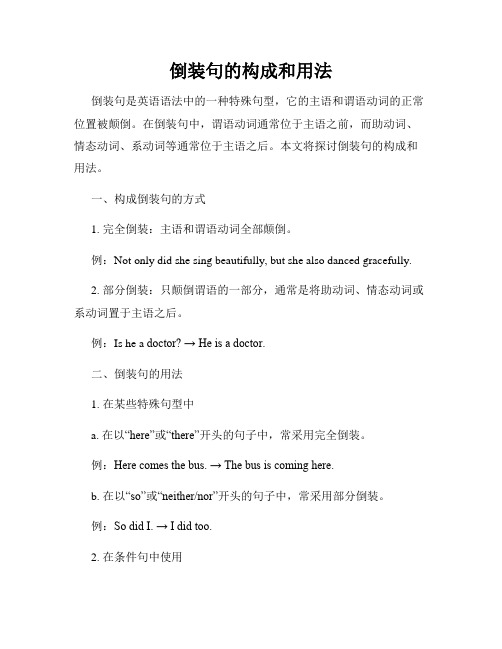
倒装句的构成和用法倒装句是英语语法中的一种特殊句型,它的主语和谓语动词的正常位置被颠倒。
在倒装句中,谓语动词通常位于主语之前,而助动词、情态动词、系动词等通常位于主语之后。
本文将探讨倒装句的构成和用法。
一、构成倒装句的方式1. 完全倒装:主语和谓语动词全部颠倒。
例:Not only did she sing beautifully, but she also danced gracefully.2. 部分倒装:只颠倒谓语的一部分,通常是将助动词、情态动词或系动词置于主语之后。
例:Is he a doctor? → He is a doctor.二、倒装句的用法1. 在某些特殊句型中a. 在以“here”或“there”开头的句子中,常采用完全倒装。
例:Here comes the bus. → The bus is coming here.b. 在以“so”或“neither/nor”开头的句子中,常采用部分倒装。
例:So did I. → I did too.2. 在条件句中使用a. 在以“should”引导的虚拟条件句中,谓语动词常倒装。
例:Should you need any help, feel free to ask me. → If you need any help, feel free to ask me.b. 在以“had”引导的条件句中,谓语动词也常倒装。
例:Had I known about the party, I would have attended. → If I had known about the party, I would have attended.3. 在祈使句中使用a. 在以“never”开头的祈使句中,常采用完全倒装。
例:Never have I seen such a beautiful sunset. → I have never seen sucha beautiful sunset.4. 表示强调或感叹的句子中使用a. 在表示强调的句子中,常采用完全倒装。
高考英语倒装句最全总结
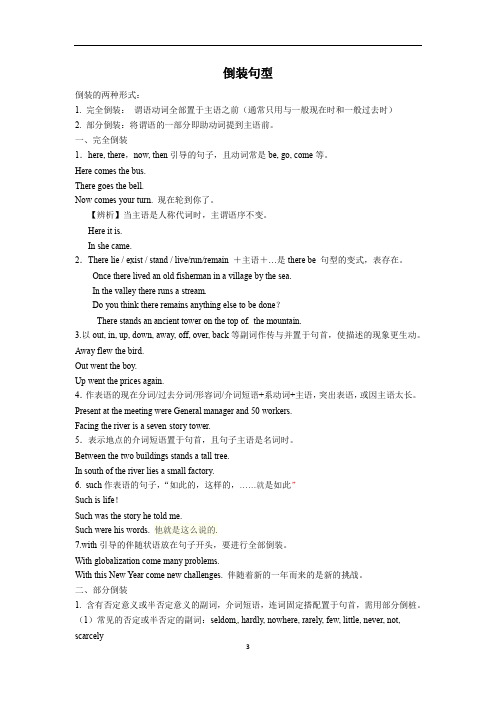
倒装句型倒装的两种形式:1. 完全倒装:谓语动词全部置于主语之前(通常只用与一般现在时和一般过去时)2. 部分倒装:将谓语的一部分即助动词提到主语前。
一、完全倒装1.here, there,now, then引导的句子,且动词常是be, go, come等。
Here comes the bus.There goes the bell.Now comes your turn. 现在轮到你了。
【辨析】当主语是人称代词时,主谓语序不变。
Here it is.In she came.2.There lie / exist / stand / live/run/remain +主语+…是there be 句型的变式,表存在。
Once there lived an old fisherman in a village by the sea.In the valley there runs a stream.Do you think there remains anything else to be done?There stands an ancient tower on the top of the mountain.3.以out, in, up, down, away, off, over, back等副词作传与并置于句首,使描述的现象更生动。
Away flew the bird.Out went the boy.Up went the prices again.4.作表语的现在分词/过去分词/形容词/介词短语+系动词+主语,突出表语,或因主语太长。
Present at the meeting were General manager and 50 workers.Facing the river is a seven-story tower.5.表示地点的介词短语置于句首,且句子主语是名词时。
Between the two buildings stands a tall tree.In south of the river lies a small factory.6.such作表语的句子,“如此的,这样的,……就是如此”Such is life!Such was the story he told me.Such were his words. 他就是这么说的.7.with引导的伴随状语放在句子开头,要进行全部倒装。
英语倒装句的用法归纳总结
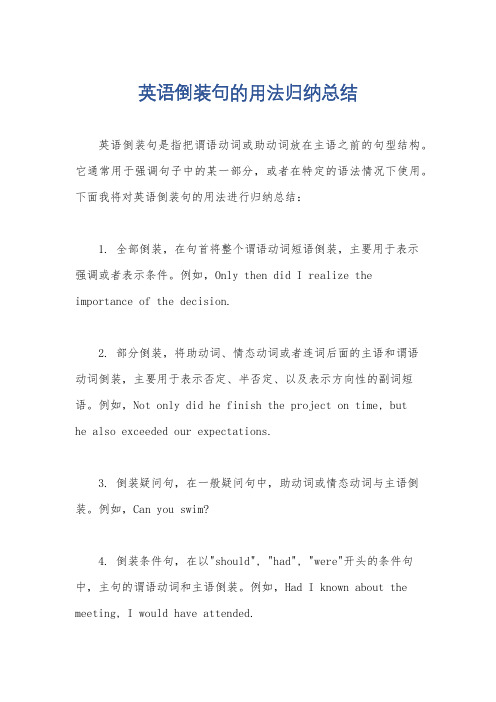
英语倒装句的用法归纳总结
英语倒装句是指把谓语动词或助动词放在主语之前的句型结构。
它通常用于强调句子中的某一部分,或者在特定的语法情况下使用。
下面我将对英语倒装句的用法进行归纳总结:
1. 全部倒装,在句首将整个谓语动词短语倒装,主要用于表示
强调或者表示条件。
例如,Only then did I realize the importance of the decision.
2. 部分倒装,将助动词、情态动词或者连词后面的主语和谓语
动词倒装,主要用于表示否定、半否定、以及表示方向性的副词短语。
例如,Not only did he finish the project on time, but
he also exceeded our expectations.
3. 倒装疑问句,在一般疑问句中,助动词或情态动词与主语倒装。
例如,Can you swim?
4. 倒装条件句,在以"should", "had", "were"开头的条件句中,主句的谓语动词和主语倒装。
例如,Had I known about the meeting, I would have attended.
5. 倒装句型用于表示方向性的副词短语,如,Here comes the bus.
总的来说,英语倒装句的使用有一定的规律,主要用于强调、
条件句、疑问句和特定的副词短语。
在写作和口语表达中,合适地
运用倒装句可以使语言更加生动有力。
希望以上总结对你有所帮助。
高中高考英语专题:倒装句语法知识汇总(全倒和半倒)
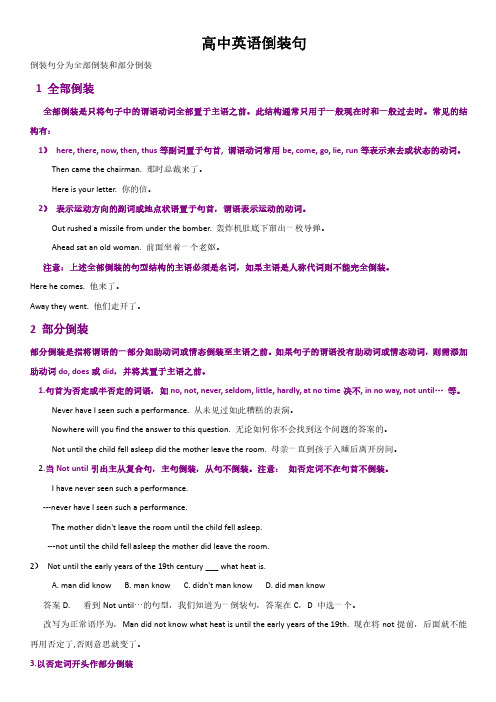
高中英语倒装句倒装句分为全部倒装和部分倒装1全部倒装全部倒装是只将句子中的谓语动词全部置于主语之前。
此结构通常只用于一般现在时和一般过去时。
常见的结构有:1)here,there,now,then,thus等副词置于句首,谓语动词常用be,come,go,lie,run等表示来去或状态的动词。
Then came the chairman.那时总裁来了。
Here is your letter.你的信。
2)表示运动方向的副词或地点状语置于句首,谓语表示运动的动词。
Out rushed a missile from under the bomber.轰炸机肚底下窜出一枚导弹。
Ahead sat an old woman.前面坐着一个老妪。
注意:上述全部倒装的句型结构的主语必须是名词,如果主语是人称代词则不能完全倒装。
Here he comes.他来了。
Away they went.他们走开了。
2部分倒装部分倒装是指将谓语的一部分如助动词或情态倒装至主语之前。
如果句子的谓语没有助动词或情态动词,则需添加助动词do,does或did,并将其置于主语之前。
1.句首为否定或半否定的词语,如no,not,never,seldom,little,hardly,at no time决不,in no way,not until…等。
Never have I seen such a performance.从未见过如此糟糕的表演。
Nowhere will you find the answer to this question.无论如何你不会找到这个问题的答案的。
Not until the child fell asleep did the mother leave the room.母亲一直到孩子入睡后离开房间。
2.当Not until引出主从复合句,主句倒装,从句不倒装。
注意:如否定词不在句首不倒装。
I have never seen such a performance.---never have I seen such a performance.The mother didn't leave the room until the child fell asleep.---not until the child fell asleep the mother did leave the room.2)Not until the early years of the19th century___what heat is.A.man did knowB.man knowC.didn't man knowD.did man know答案D.看到Not until…的句型,我们知道为一倒装句,答案在C,D中选一个。
高中英语语法倒装总结全

倒装句倒装的两种考法:1. 放在单项选择题中,考查考生的倒装语法知识是否熟练掌握;2. 放在完形填空和阅读理解中,设置理解障碍.倒装的两种形式:1. 完全倒装:将整个谓语动词提到主语前.2. 部分倒装:即半倒装,将谓语的一部分即助动词提到主语前.一、完全倒装1表方位的副词here, there 或out, in, up, down, away, off, over, back等标志词放在句首,句子用完全倒装.翻译句子1车来了. Here comes the bus.2铃响了. There goes the bell.3孩子们冲出来了. Out rushed the children.4那个男孩离开了. Away went the boy.疑难Here it is.In she came.Away he went.疑难剖析当主语是人称代词时,主谓语序不变.2地点状语放在句首且谓语动词为come, live, lie, go, sit, stand等时用完全倒装.完成例句5河的南面有一家小工厂.In south of the river lies a small factory. 6山谷里传来一声喊叫.From the valley came a cry.3 such, the following等放句首时,句子要完全倒装.翻译句子7Such are the facts. 情况就是如此.8生活就是这样. Such is life.9The following is the answer to the question. 这个问题的答案如下.4There lie / exist / stand / live +主语+…是there be 句型的变式翻译句子10山顶上有一幢高楼.There is a tall building on the top of the mountain.11山顶上耸立着一座古塔.There stands an ancient tower on the top of the mountain.5“表语+系动词+主语”的结构.例句观察Present at the party were Mr. Green and many other guests.出席晚会的有格林先生,还有一些别的宾客.Seated on the ground are a group of young men. 坐在地上的是一群年轻人.注意此时,主语较长,可还原为正常语序即:主+系动词+表语.二、部分倒装将情态动词、助动词、be提到主语前. 通常可以还原为正常的语序,并以此检验倒装句是否正确.1含有否定意义的副词或短语如:few, little, never, not, nowhere, rarely, seldom, at no time, by no means, in no case等放在句首时,需用部分倒装.翻译句子12Little does he know about the news. 他对这消息知之甚少.13By no means can he catch up in such a short time. 他根本不可能在这么短的时间里赶上来.疑难1He is active in personality, and he seldom stays indoors. 无助动词He is active in personality, and seldom does he stay indoors. 添加does疑难剖析1若原句中没有助动词,必须根据谓语动词的具体时态来确定相应的助动词do, does 或did.完成例句14—我有大量的工作要做.— I've got an enormous amount of work to do.—我也是.—So have I.15他,和他全家人一样,相信你是无辜的.He believed, as did all his family, that you were innocent. 16如果她不同意这个计划,Tom也不会同意.If she doesn‘t agree to the plan, neither will Tom.2so / as / neither / nor 为标志词放在句首时,句子用倒装.①表示前面所说的肯定情况,也适合于另一人或物时,句式如下:so / as + be 助动词或情态动词+主语.②表示前面所说的否定情况也适合于另一人或物时,句式如下:neither nor+ be 助动词或情态动词+主语.特别提醒①“so +主语+助动词或be动词”表示对上文肯定的内容加以肯定或赞同,意为“的确如此”;— It's raining hard. 天下着大雨.— So it is. 是的.②“主语+did +so”表示:“主语”这样做了. 例如:Tom asked me to go to play football with him and I did so. Tom要我去踢足球,我去了.3①“only +状语或状语从句”放在句首时,句子用部分倒装.②only之后跟的不是状语时不可倒装.完成例句17你只有用这种方法才能学好英语.Only in this way can you learn English well.18只有他有时间的话他才会来.Only if he has time will he come here. 19他被请了3次才来开会.Only after being asked three times did he come to the meeting.20Only that boy can work out the problem. 只有那个男孩才能解答出这个问题.21Only socialism can save China. 只有社会主义才能救中国.4在if引导的虚拟语气条件句中,从句谓语有助动词were, had, should 时,可将if 省略,而把 were, had, should 移到句首.翻译句子22如果我是你,我就不会那样做. Were I you, I wouldn't do that.特别提醒①若从句是否定句,则必须将 not放在主语后.② had必须是助动词.5在“so…that” 和“ such…that”结构中,将“so+adj. ”和“such+n. ”提到句首时,句子用部分倒装.完成例句23暴风雨如此厉害,整个屋顶都被吹掉了.So terrible was the storm that the whole roof was blown off. 24杰克是如此聪明的孩子,他能解答所有这些难题.Such a clever boy was Jack that he was able to work out allthese difficult problems.6often, always, once, many a time, now and then, every the other day, then等状语位于句首时,句子部分倒装.完成例句以前我经常提到他.Often did I speak of him.他常常帮助我做实验.Many a time has he helped me with my experiment.7在not…until…, no sooner…than…, scarcely/hardly…when,not only…but also…, neither…nor…,等否定词开头的句式中.完成例句约翰知道昨天才改变了主意Not until yesterday did John change his mind.她一坐下,电话就响了.Hardly had she sat down when the phone rang.他没去拜访她,他也不会这样做.Neither has he called on her,nor will he do so.她不但说的正确,而且说的流利.Not only did she speak correctly, but also she spoke fluently.8当as /though引导让步状语从句时,可出现“N/adj/adv/分词+as +S+V”或“V+as+S+助动词”的倒装形式.当表语是名词时,名词前不加任何冠词.完成例句尽管他们很勇敢,但这样的危险仍使他们感到畏惧.Brave as they were, the danger made them afraid.尽管他是孩子,但是他知道的很多.Child as he is, he knows a lot of things.虽然尝试了,但是她打不开门.Try as she might, she couldn’t get the door open.8当may 放句首,表达祝愿时,句子倒装.May you succeed.。
倒装句的构成与用法解析完全倒装部分倒装的情况与例句

倒装句的构成与用法解析完全倒装部分倒装的情况与例句倒装句的构成与用法解析倒装句是英语语法中常见的一种句型,它的构成和用法可以分为完全倒装和部分倒装。
本文将详细解析这两种倒装句的特点、构成和用法,并通过丰富的例句来加深理解。
一、完全倒装1. 介词短语置于句首完全倒装中最常见的一种形式是当句子开头是介词短语时,将主语与谓语动词的位置交换。
这种倒装结构常用于表示地点、时间、条件或方式。
例句1: Under the tree stood a little girl, her eyes sparkling with joy.(树下站着一个小女孩,她的眼睛闪烁着喜悦。
)例句2: In front of the house run a group of children, laughing and playing.(房子前面跑着一群孩子,笑声不断。
)2. 表示地点或时间的副词或短语位于句首类似于介词短语的情况,表示地点或时间的副词或短语也可以引起完全倒装。
例句3: Here comes the bus, finally.(终于来了公交车。
)例句4: Now is the time for us to take action.(现在是我们采取行动的时候了。
)3. 否定副词或短语位于句首当否定副词或短语位于句首时,也会引起完全倒装。
常见的否定副词包括never、rarely、hardly、seldom等。
例句5: Never have I seen such a beautiful sunset before.(我从未见过如此美丽的日落。
)例句6: Hardly had I finished my homework when the phone rang.(我刚写完作业电话就响了。
)二、部分倒装1. 助动词、情态动词或be动词位于句首部分倒装中最常见的一种形式是将助动词、情态动词或be动词置于句首,并与主语之间构成部分倒装结构。
全部倒装和部分倒装知识点

全部倒装和部分倒装知识点倒装是英语中的一种语法结构,常见于特殊句型或句子的词序变换。
倒装分为全部倒装和部分倒装两种形式。
全倒装是指谓语动词与主语互换位置,而部分倒装是指谓语动词中的助动词或其他辅助动词与主语互换位置。
一、全部倒装1. 在以表示方向、距离、时间等副词开头的句子中,常用全部倒装结构,即把谓语动词完全提到主语之前。
常见的副词有here, there, now, then等。
例如:There goes the bell. (这是句确句式,意思是“铃响了。
”)2.以否定副词开头的句子也常用全部倒装。
例如:Never have I seen such a beautiful sunset. (我从未见过如此美丽的日落。
)Rarely do we go to the cinema. (我们很少去电影院。
)3.在倒装句中,当句首为状语从句时,主句也要全部倒装。
例如:If only I had known the truth, I would have acted differently. (要是我早知道真相,我会有所不同的行动。
)When she arrived, so did he. (她到达时,他也到了。
)4.在以“介词+疑问词”开头的句子中,常用全部倒装。
例如:By what means was he able to escape? (他是用什么方法逃脱的?) With whom did you go to the party? (你和谁一起去的派对?)二、部分倒装1. 当句子以否定词或含有否定意义的词开头时,助动词或系动词要与主语调换位置,并在助动词或系动词后加not。
例如:They are not studying English. (他们不在学英语。
)2. 当so/such引导的结果状语从句位于句首时,要进行倒装。
例如:So tired was he that he fell asleep immediately. (他太累了,以至于立刻睡着了。
英语语法 倒装句

倒装英语句子的正常语序(Normal Order)是主语放在谓语动词前。
如果句子的谓语动词位于主语之前,这种语序被称作倒装语序(Inverted Order)。
倒装语序有全部倒装和部分倒装两种。
一般说来,英语中有两种情况需要使用倒装句:一种是由于语法结构的需要而进行的倒装,另一种是由于修辞需要而进行的倒装。
1.全部倒装:1)There be 句型:还有live, happen, exist, remain, stand, sit, lie, seem等作这类句型的谓语There are many students in the classroom. There live / exist a variety of beings around the corals.There happened to be no body in the bedroom when the fire broke out.There lies a large Greenland in front of the house .2)Here / there / now + vi(常为come, go)+主语(必须是名词)(这时句中不能用正在进行时)此句型中here / there (用来唤起注意)喂,注意了Here comes Mary. There goes the bell. Here comes the bus. 但:There he comes.here句中也可用系动词Here is John. Here are some story books I want.Here we are. This is the station. 咱们到了,这就是火车站。
“Give me some paper.”“Here you are.”“给我点纸。
”“给你。
”3) then引起,谓语为come, follow的句子Then came a new difficulty. 然后产生了一个新的困难。
英语的倒装句整理归纳

英语的倒装句整理归纳英语倒装句句型的结构有两种:部分倒装和完全倒装。
一、部分倒装部分倒装其实也很简单,我们只需要记住,它完全和疑问句结构一样,要把谓语的一部分(即系动词be;助动词do, have,be, will;情态动词can, must should等)提到主语之前。
Not only is he humorous, but he is also kind to the kids.他不仅幽默,而且对孩子们也很好。
Seldom does the boy eat lamb.这个男孩很少吃羊肉。
Little can we do to help the poor man.我们帮不了这个可怜的人。
部分倒装具体情况:1,否定词never及部分否定词rarely和seldom在句首:Never have I been felt so frustrated!我从来没有这么沮丧过!Seldom has she done anything more foolish.她很少干过比这更愚蠢的事。
注意,句子中往往是完成时态且可能含有比较级。
2,部分否定词hardly, barely, no sooner, or scarcely在句首:No sooner had she got in the bath than the doorbell rang.她刚开始洗澡,门铃响了。
No sooner had we reach the bus station than the bus came.我们一到公共汽车站,公共汽车就来了。
Barely had I closed the door when the phone rang.我刚关上门,电话就响了。
注意,这类句子中一般有先后接连发生的两个动作。
所以从主句多用过去完成时。
3, 部分否定词Little在句首:Little have I read about archeology.我很少读考古学方面的东西。
倒装(全部装和部分倒装)

倒装(全部倒装和部分倒装)在英语中,主语和谓语的语序通常是主语在前,谓语在后。
但有时谓语的全部或者一部分(通常是助动词或情态动词)却提到主语的前面,这种语序叫做“倒装”。
在倒装语序中,若整个谓语都在主语之前,称为全部倒装。
若只将助动词、情态动词或连系动词be等谓语的一部分放在主语之前,称为部分倒装。
Part 1:全部倒装(1)there be句型。
在此句型中,there是引导词,动词be后才是真正的主语。
其中be可换为appear, enter, come, exist, happen, lie, live, remain, seem, stand等动词。
There be +主语+其他正装:No schools or hospitals were there before.倒装:There were no schools or hospitals there before.正装:Some serious problems exist in the management of the company.倒装:There exist some serious problems in the management of the company.正装:An event happened last week.倒装:There happened an event last week.(2) 在表示方向、时间、地点的副词或某些表示地点的介词词组开头的句子里,如:副词here, there, now, then, in, out, away, up, off, down, back, over, in front of等,谓语动词是be,come, follow, go, begin等,且主语是名词时,句子全部倒装,以示强调。
公式:表示方向、时间、地点的副词/表示地点的介词词组+谓语+主语There goes the bell.Here comes the bus.正装:The bus comes here.The children rushed out the moment the bell rang.倒装:Out rushed the children the moment the bell rang.The chairman came then.倒装:Then came the chairman.A small garden was in front of the house.倒装:In front of the house was a small garden.A big steel factory lies south of the city.倒装:South of the city lies a big steel factory.注意:主语是代词时,主语和谓语不倒装。
英语倒装句的四种基本句型例句

英语倒装句的四种基本句型例句嗨,小伙伴们!今天咱们来好好唠唠英语倒装句的四种基本句型,这可真是英语学习里超有趣的一部分呢。
就像一场奇妙的语言魔术,让句子变得超级有特色。
**一、完全倒装(Full Inversion)**完全倒装就是把整个谓语动词都放到主语之前啦。
这就好比是把一场演出的主角(主语)和配角(谓语)的出场顺序完全颠倒了一下,给人一种很新奇的感觉。
例句1:There goes the bell.(铃响了。
)你看,正常的语序应该是The bell goes there. 但是这样一倒装,就有一种突然性,就像你正等着什么事情发生,然后“铃就响了”,这种表达更加生动。
我还记得我刚学这个的时候,我同学问我:“为啥要这么说呀?直接说The bell goes there不就得了?”我就跟他说:“哎呀,这就像你去看魔术表演,魔术师要是按平常的方式出牌,那还有啥惊喜呢?这种倒装句就像魔术里的大变活人,突然把主语和谓语的位置变了,让句子变得超酷。
”例句2:Here comes the bus.(公共汽车来了。
)想象一下,你在车站等车等得心急火燎的,然后你大喊一声“Here comes the bus”,是不是感觉比“The bus comes here”更带感呢?这时候句子就像是一个充满活力的小助手,快速地把重要的信息“bus来了”传达给你。
例句3:Away flew the birds.(鸟儿飞走了。
)这个句子要是正常说就是The birds flew away. 可一旦倒装,就像是我们在描述一个很突然的画面,鸟儿“嗖”的一下就飞走了,那种动态感更强了。
我跟我的英语老师讨论这个句子的时候,老师说:“你看,这种倒装就像是给句子加了个加速器,让动作更迅速地呈现在读者或者听者的脑海里。
”我当时就觉得,哇塞,真的是这样呢!**二、部分倒装(Partial Inversion)**部分倒装呢,就是只把助动词、情态动词或者be动词放到主语前面,主要动词还在主语后面呢。
- 1、下载文档前请自行甄别文档内容的完整性,平台不提供额外的编辑、内容补充、找答案等附加服务。
- 2、"仅部分预览"的文档,不可在线预览部分如存在完整性等问题,可反馈申请退款(可完整预览的文档不适用该条件!)。
- 3、如文档侵犯您的权益,请联系客服反馈,我们会尽快为您处理(人工客服工作时间:9:00-18:30)。
全倒装和半倒装1. 完全倒装1) 完全倒装即把整个谓语放到主语之前(是整个谓语动词,而非助动词)。
例如:In came the teacher and the class began. (老师走了进来,然后开始上课。
)(这类词通常有:away in out up)2) there引出的完全倒装句:除了最常见的there be句型以外,there还可以接appear, exist, lie, remain, seem to be, stand等,一般都译成"有"的含义,构成完全倒装句。
例如:There appeared to be a man in black in the distance.(远处有个穿黑色衣服的人。
)3) 由地点和时间副词引出的完全倒装句:以地点副词here, there和时间副词now, then 开头,后面的动词是be, come, exist, fall, follow, go, lie, remain, seem, stand等,而主语又是名词时,构成完全倒装句。
例:Under that tree sits a beautiful girl.(那棵树下坐着一位美丽的姑娘。
)例:_________ from the tenth floor when the policeman pointed his pistol at him.A) Jumped down the burglar B) Down the burglar jumpedC) The burglar jumps down D) Down jumped the burglar答案是D) Down jumped the burglar。
因为地点状语Down位于句首应该用完全倒装,整个谓语动词应位于主语之前。
C) The burglar jumps down虽然是自然语序,但时态错误,应该用和时间状语从句一致的过去时,而不是现在时。
注意:1) 在here, there引出的倒装句中,当主语是普通名词时用完全倒装句,但当主语是代词时,就要用部分倒装句。
例:Here comes the postman!(邮递员终于来了!注意实意谓语动词位于主语之前。
)Here we are.(我们到了。
注意系动词位于主语代词之后。
)2) 注意正语序和倒装语序的语气、意义是区别:例:Here is the picture I love.(这正是我所喜爱的画。
)The picture I love is here.(我所喜爱的画在这里。
)3) 当主语是代词,谓语是系动词,表语是说明性的词、词组和定语从句时,可以使用完全倒装句,起强调作用。
例:Lucky is he who has been enrolled into a famous university.(他真幸运,被一所名牌大学录取了。
)2. 部分倒装1) 部分倒装即只把谓语的一部分(如助动词、情态动词等)放到主语前,或把句子的强调成分提前。
例:_______ right now, she would get there on Sunday.A) Would she leave B) if she leaveC) were she to leave D) If she had left结合选项,全句的意思是:“如果她立刻就走,她就能在星期天到达那里”。
答案是C。
2) 以否定词开头的句子要求部分倒装。
注意下列句子中助动词或情态动词提前、甚至补充助动词的用法:例:Not until yesterday did little John change his mind.(小约翰直到昨天才改变了主意。
)例:In no country ______ Britain, it had been said, can one experience four seasons in the course of a single day.A) better than B) more than C) other than D) rather than本题是个倒装句,答案是C) other than。
no other than意思是“正是、就是”;而rather than的意思是“宁愿……而不……;而不是”。
3) 以否定副词开头并加状语的句子要求部分倒装。
这些否定副词有barely, hardly, little, seldom,scarcely……when, never, no sooner……than, rarely, no more, nor nearly, not only等以及only。
例:Only under special circumstances _________ to take make-up tests.A) are freshmen permitted C) permitted are freshmenB) freshmen are permitted D) are permitted freshmen全句的意思是:“一年级学生只有在特殊的情况下才可以允许补考。
”本陈述句以only开始,后面接状语,应当用部分倒装句。
所以答案是A) are freshmen permitted。
如用自然语序,本题所在的句子就应该改写为:Freshmen are permitted to take make-up tests only under special circumstances.这两句话的差别是,前者将only under special circumstances放到句首,表示对状语的强调。
注意:在部分倒装句中,只有助动词、情态动词或连系动词to be可以置于主语之前,其它部分都要置于主语之后。
注意:a) 如果含有从句时,只要求主句倒装:例:Only after he had spoken out the word did he realize he had made a big mistake.(只有当他已经说出那个字后才意识到自己犯了个大错误。
)b) 如果上述否定副词出现在强调句型中的前半部分,不用倒装:例:It was not until he went abroad that he know the truth of the fact.(直到他出国以后才了解到事实真相。
)c) 如果hardly, scarcely后面接的是any, ever, at all时,意义类似almost no/ not/ never(几乎不、从不),则无须倒装。
例:Hardly any people having been invited went there.(几乎没有什么受到邀请的人去那里了。
)4) 由no matter how, however和how引导的状语从句要求部分倒装,因为形容词或副词通常紧跟在这三个引导词后面,然后才是主语和谓语,形成形式上的部分倒装句:例:I know nothing about this river, neither how long, how wide nor how deep it is.(我一点也不了解这条河,不知道它有多长,多宽或多深。
)由as引导的部分倒装句:a) 当as作为比较意义时,即用于as + adj./ adv. + as结构中时,如果把第一个as省略掉,就形成部分倒装句。
例:Cautious as the rest of her family (was) , she didn't seem willing to give an immediate reply to my question.(正如她家里人一样谨慎小心,她似乎不愿意立即回答我的问题。
)She ran down the stairs, quick as a rabbit (ran).(她跑下楼去,跑得象兔子那么快!)b) 当as引导让步状语时,和although, though一样,当用作“尽管”之义时,可以用于部分倒装句。
例:_______, there was no hope of her being able to sleep.A) As she was exhausted B) If she was exhaustedC) Exhausted though she was D) Now that she was exhausted答案是C) Exhausted though she was。
从属连词as, though可以用于让步状语从句中。
这种从句必须以形容词(或形容词化的分词)、名词或动词原形开头,主语必须位于从句之后。
D) Now that she was exhausted 里的引导词Now that表示“既然”;B) If she was exhausted表示条件“如果”;A) As she was exhausted表示“由于”(因为使用的是正语序),都与后面句子的意思不通顺。
c) 表示原因时,为了强调起见,也可以倒装。
例:Tired as he was, we decided not to disturb him.(因为他太累了,我们决定不打扰他。
)d) 等于so时,意义是“也,也是”例:She worked hard, so/ as did her husband. (她工作很努力,她的丈夫工作也很努力。
)3. 其它情况的倒装句1) so, neither, nor除了构成上述倒装句以外,还可以取代上文出现的名词、形容词甚至整句话,构成完全倒装句或部分倒装句。
但这两种倒装的意义不同。
a) 当so表示“也,相同,那样”时,通常表示对前一句肯定句的赞同、一致内容,要求使用完全倒装句:例:I asked him to complete the experiment before five, so he did (=and he did that).(我让他在5点以前完成实验,他做到了。
)b) so /such ……that句型可以构成部分倒装句,表示强调so /such和that之间的部分:例:So unreasonable was his price that everybody startled.(他的要价如此之高,令每个人都瞠目结舌。
)To such length did she go in rehearsal that the two actors walked out.(她的彩排进行得那么长,以致于两个演员都走出去了。
)c) neither和nor共有4种倒装形式,其含义分别为:完全倒装时:表示"也不",和上文a)用法正好相反,表示对前一句否定句的赞同或一致内容。
